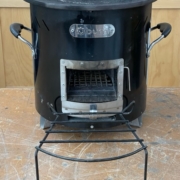Mass, Insulation and Thermal Efficiency

It is more likely that close to 50% thermal efficiency will be achieved with a biomass burning stove when:
- Small sticks are burned that produce tall, hot flames while using the least amount of wood.
- A 30cm in diameter aluminum pot is used with a 14cm high pot skirt that creates a 6mm channel gap.
- The stove top (with 6mm pot supports) weighs as little as possible. The narrow channel gaps in the stove top effectively deliver wasted heat from the hot gases into the stove top while increasing beneficial convective heat transfer into the pot, so less mass to hold the heat is better.
- A grate helps the sticks to make tall, hot flames and reduces the made charcoal.
Starting with all of the above, we tested various Rocket stove combinations to try to determine the effect of mass in the combustion chamber. The Kuniokoa Rocket stove is the lightest Rocket stove in our museum – it is made from sheet metal without insulation. (A refractory metal combustion chamber lasts longer when uninsulated.) When tested at high power (4,645 watts) the thermal efficiency was 51.7%, PM2.5 was Tier 2, and CO was Tier 3. Thermal efficiency dropped to 46.1% when we exchanged the Kuniokoa sheet metal stove top (0.31 kilo) with a cast iron version (2.36 kilo).
A similar Shengzhou Stove Manufacturer (SSM) Rocket stove was tested with a refractory cement combustion chamber (2.7 kilo) surrounded with rock wool insulation. The stove top was made from lightweight 304 stainless steel. When tested at high power (4,816 watts) the thermal efficiency was 48.6%, PM2.5 was Tier 2, and CO was Tier 3. The refractory cement combustion chamber is heavier but it can be insulated because the material has a working temperature of 1,100°C.
When a SSM lighter refractory ceramic combustion chamber (1.2 kilo) was exchanged into the SSM Rocket stove with rock wool insulation and a lightweight 304 stainless steel stove top, the thermal efficiency (at 4,709 watts) rose to 51.4%, with Tier 2 for PM2.5 and Tier 3 for CO.
- It may be that insulating a one kilo combustion chamber in a Rocket stove offsets the disadvantage of the higher mass when compared to uninsulated sheet metal.
- In these tests, adding another kilo to the insulated combustion chamber in the SSM Rocket stove lowered thermal efficiency from 51% to 46%.
- When the mass of the stove top was increased from 0.3 to 2.3 kilos, thermal efficiency dropped by about 5%.



